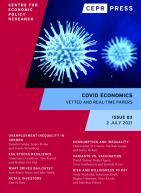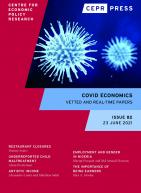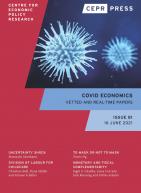
Using a hand-collected database of partial business closures for all U.S. counties from March through December 2020, we examine the impact of capacity restrictions on fatality growth due to COVID-19. For the restaurant and bar sector, we find that several combinations of partial capacity restrictions are as effective as full shutdowns. Point estimates indicate that, for the average county, limiting restaurants to 25% of capacity and bars to outdoor service reduces the fatality growth rate six weeks ahead by approximately 41%, while completely closing them reduces fatality growth by about 32%. For gyms, we find that, while full closures reduce the COVID-19 fatality growth rate, partial closures may be counterproductive relative to leaving capacity unrestricted. For salons and other personal services, we find mixed evidence that limiting them to 25% of capacity reduces fatalities. However, other constraints are either ineffective or even counterproductive.
Citation
Tookes, H and M Spiegel (2021), ‘All or nothing? Partial business shutdowns and COVID-19 fatality growth‘, COVID Economics 77, CEPR Press, Paris & London. https://cepr.org/publications/covid-economics-issue-77#392514_392953_390765
Quick vaccine rollouts are crucial for a strong economic recovery, but vaccine hesitancy could prolong the pandemic and the need for social distancing and lockdowns. We use individual-level data from nationally representative surveys developed by YouGov and Imperial College London to empirically examine the determinants of vaccine hesitancy across 17 countries and over time. Vaccine demand depends on demographic features such as age and gender, but also on perceptions about the severity of COVID-19 and side effects of the vaccine, vaccine access, compliance with protective behaviors, overall trust in government, and how information is shared with peers. We then introduce vaccine hesitancy into an extended SIR model to assess its impact on pandemic dynamics. We find that hesitancy can increase COVID-19 infections and deaths significantly if it slows down vaccine rollouts, but has a much smaller impact if all willing adults can be immunized rapidly.
Citation
Sollaci, A, H Khan, F Lima and E Dabla-Norris (2021), ‘Who doesn’t want to be vaccinated? Determinants of vaccine hesitancy during COVID-19‘, COVID Economics 77, CEPR Press, Paris & London. https://cepr.org/publications/covid-economics-issue-77#392514_392953_390764
Once new Covid vaccines were approved, vaccinating the population as quickly as possible became paramount. However, in the presence of adjustment costs firms will increase production capacity only gradually. The existing contracts specify solely that a fixed quantity is to be supplied within a specified period. At fixed prices, this kind of contract provides no incentive for an accelerated build-up of vaccine production capacities within the stipulated delivery period. With adjustment costs, the price is however very sensitive to the length of the delivery period (elasticity of3). An optimal contract would specify a decreasing price schedule over time that can replicate the social optimum. We show in particular that different forms of adjustment costs, whether they are defined in relation to absolute or proportional increases in capacity, can lead to qualitatively different production profiles over time. Evidence from Covid vaccines is not compatible with the textbook model of adjustment costs, which assumes a relation to proportional increases in production. We also show that if governments had chosen the delivery time so as to minimize social losses, they would have spent much more on vaccine production.
Citation
Gros, D and C Gros (2021), ‘Incentives for accelerating the production of Covid-19 vaccines in the presence of adjustment costs‘, COVID Economics 77, CEPR Press, Paris & London. https://cepr.org/publications/covid-economics-issue-77#392514_392953_390763
This paper analyses the impact of the pandemic crisis in a dual labour market, using monthly data covering the universe of individuals registered as unemployed in 278 Portuguese municipalities, between March and August 2020. Our event studies document a large causal impact of the pandemic of up to 40 percentage points increases in year-on-year growth rates of the monthly stock of unemployed. We document the asymmetric impact of the crisis by employing triple difference-in-differences. Younger workers, below the age of 35, are between 20% and 25% more likely to be unemployed, vis-à-vis the older than 55. Middle educated individuals are at least 15% more likely to be unemployed when compared to the highly educated ones. There are no differences across genders for transitions into unemployment, but women have lower job placements than men. The effects are exacerbated by the duality of the labour market: an increase of one standard deviation in the municipal share of temporary contracts causes a rise of 11.6% in the number of unemployment registries and magnifies the socio-demographic asymmetries. Our results can be interpreted as a lower bound of the impact of the crisis on the labour market, given the furlough scheme implemented in Portugal.
Citation
Tavares, J, J Pereira Dos Santos, C Nunes, S Peralta and B Carvalho (2021), ‘Failing young and temporary workers: The impact of Covid-19 on a dual labour market‘, COVID Economics 77, CEPR Press, Paris & London. https://cepr.org/publications/covid-economics-issue-77#392514_392953_390762
With COVID-19 having caused significant disruption to the global education system, researchers are beginning to become concerned with the impact that this has had on student learning progress and, in particular, if learning loss has been experienced. To evaluate this, we conduct a thorough analysis of recorded learning loss evidence documented between March 2020 and March 2021. This systematic review aims to consolidate available data and document what has currently been reported in the literature. Given the novelty of the subject, eight studies were identified; seven of these found evidence of student learning loss amongst at least some of the participants, while one of the seven also found instances of learning gains in a particular subgroup. The remaining study found increased learning gains in their participants. Additionally, four of the studies observed increases in inequality where certain demographics of students experienced learning losses more significant than others. It is determined that further research is needed to increase the quantity of studies produced, their geographical focus, and the numbers of students they observe.
Citation
Patrinos, H and R Donnelly (2021), ‘Learning loss during COVID-19: An early systematic review‘, COVID Economics 77, CEPR Press, Paris & London. https://cepr.org/publications/covid-economics-issue-77#392514_392953_390761


Covid Economics - Issue 82
- Restaurant Closures during the Pandemic: A Descriptive Analysis
- Underreporting Child Maltreatment during the Pandemic: Evidence from Colorado
- Covid-19 impact on Artistic Income
- COVID-19, Employment, and Gender: Evidence from Nigeria
- The Importance of Being Earners: Modelling the Implications of Changes to Welfare Contributions on Macroeconomic Recovery
